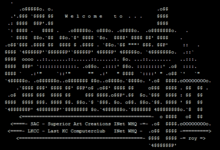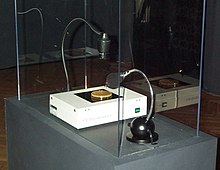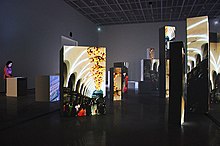Media art
The term media art describes artistic work that makes use of the media, which are mainly used in the 20th and 21st centuries. Century, such as film , videos , holographs , Internet , computers , mobile telephony , games, etc. In English, however, the term media art is sometimes used synonymously with new media art . New media are each carrier, mediator or working material in art .
Designations
Depending on which medium is mainly used in the artistic creation process, instead of the term media art , a sub-term is sometimes used to denote a separate art form such as B. digital art (see also digital media ), video art , computer art , robot art or electronic art. In the case of the latter examples, the respective technical media / devices must also serve as namesake for these art forms. It is currently unclear whether these terms will last in the long term. However, abstract media such as computer networks , computer games or abstract languages such as programming languages or mathematics can also be carriers or mediators of art . The corresponding art movements are referred to as net art , game art (English video game art and art game ), software art or mathematical art .
These processes can be social, technical or aesthetic in nature. This approach shows a closeness to conceptual art . If the process is in the foreground ( process-based art ), the description of the process itself is often used to designate the special art form, such as generative art , interactive art , performative art .
In media art, artists often appear as programmers and program developers. Many media artists are self-taught - for example in the visual or technical / mathematical field. Media arts training that is explicitly geared towards digital media has only existed for a few years. There have been courses in media art at numerous German and international universities since the 1970s. They all have different directions and goals.
history
The origins of media art are linked to the development of photographic techniques (an example from the 16th century: the zoetrope ). The first artists to be counted as media art mostly worked in the field of experimental film, such as Norman McLaren , Evelyn Lambart , Oskar Fischinger , Alexandre Alexeieff , Claire Parker , Len Lye or Mary Ellen Bute . Nam June Paik , Joseph Beuys and Wolf Vostell , who originally belonged to the Fluxus , are the most famous artists who have worked with the media of video and television . Frieder Nake , Georg Nees and A. Michael Noll have been pioneers in the history of computer art since the 1960s and Max Bense conceptually since the 1950s . From the field of conceptual art, Lawrence Weiner , Jeffrey Shaw , Fleischmann & Strauss , Jan-Peter ER Sonntag and Peter Weibel can be counted among the media artists.
In 1979 the Kölnischer Kunstverein exhibited a video installation by Marcel Odenbach . From the 1970s onwards, video installations played an important role in the establishment of media art as a branch of equal value to traditional media. Under the title Art and Technology. Departure into new realities Jürgen Claus presented an important exhibition in Bonn (BMFT) in 1984 with the focus on holography, computer art, video, cybernetic sculptures, cable TV and video discs. From the late 1980s, video works at international exhibitions such as For example, the Documenta ( Marie Jo Lafontaine, for example, is already represented at Documenta 8) or the Venice Biennale, the image and temporarily push art forms such as painting into the background. In 1989 Wulf Herzogenrath organized an exhibition Video Sculpture retrospectively and currently 1963–1989 at the Kölnischer Kunstverein . Other important artists are the Americans Bruce Nauman and Bill Viola .
At the instigation of Wulf Herzogenrath as director of the Kunsthalle Bremen initiated and supported the Federal Cultural Foundation in 2006, the project 40jahrevideokunst.de . At the same time, a total of 59 historical and current video tapes from 1963 to the present day were shown in five museums, including the Bremen Kunsthalle, the Lenbachhaus , Munich and the Museum of Fine Arts in Leipzig . The works are now temporarily accessible in the archives of various collections and institutions.
The history of media art is researched in particular through the conference series Re: On the Histories of Media, Art, Science and Technology , launched in 2005 by Oliver Grau .
Institutions
The Ars Electronica Festival in Linz, founded in 1979, plays an important role in establishing the new media in the art world . In Germany plays since its founding in 1989, which is now under the direction of Peter Weibel standing Center for Art and Media (ZKM) in Karlsruhe with its museum, institutes and the connection to the national Academy of Design , an important role for the development media art and research on the media themselves.
The Edith Russ House for Media Art in Oldenburg is also committed to the exhibition focus on media art. The house, founded in 2000, not only realizes several exhibitions a year, but has also been awarding three six-month work grants a year to international media artists since 2001, thanks to the Lower Saxony Foundation.
The first international master's degree in Media Art and History has existed at the Department of Visual Sciences at Danube University since 2005, and the Art and Multimedia bachelor’s degree at the Department of Art Education at Ludwig Maximilians University in Munich since 2007.
The imai - inter media art institute foundation in Düsseldorf has been dedicated to the distribution, preservation (conservation, restoration, digitization), mediation and art-scientific keywording of media art since 2006.
The Hartware MedienKunstVerein in Dortmund has been dedicated to the presentation, production, communication and discourse in this area since 1996. The Nam June Paik Award for media art has been presented by the Kunststiftung NRW since 2002 .
The Werkleitz Gesellschaft eV in Halle (Saale) supports professional artists and young artists, realizes and presents film culture and media art, from short films and documentaries to interactive installations and internet projects. The annual Werkleitz Festival, which emerged from the Werkleitz Biennale, is an important international presentation platform for film and media art in the new federal states.
The extensive scholarship and funding program European Media Artists in Residence Exchange, A38 production scholarship, Werkleitz project funding, Supported Artist from Werkleitz supports and networks individual artists from home and abroad. Since 2011, Werkleitz has been offering the highest-quality practical training for documentary filmmakers and media professionals in Eastern and Central Germany with the Professional Media Master Class lasting several months. The in-house technology rental offers professional equipment for non-commercial film and video productions and is available to advise. Werkleitz is institutionally funded by the state of Saxony-Anhalt.
In Switzerland, the plug.in and the resulting House for Electronic Arts Basel in Basel is important in mediating between media art and the public as well as in networking among media artists. Dock18 takes on a similar position for the Zurich area .
Study locations
- University of Graphics and Book Art Leipzig
- Art Academy for Media Cologne
- Bauhaus University Weimar
- State University of Design Karlsruhe
- Burg Giebichenstein University of Art and Design Halle
- Zurich University of the Arts
- Danube University Krems
- University of Art in Berlin
- Offenbach am Main College of Design
- Academy of Fine Arts Munich
- Ludwig-Maximilians-University Munich
- University of Applied Arts Vienna
- Bern University of the Arts
- University of the Arts Bremen
- Muthesius Academy of Art in Kiel
- Salzburg University of Applied Sciences
- University for Artistic and Industrial Design Linz
- State Academy of Fine Arts Stuttgart
See also
- Video art
- Digital Sparks Award
- Expanded Cinema
- Infermental
- Media scape
- Strictly Berlin
- Transmediale
- Media art research
- digital art
- Radio play and media art
- Werkleitz Society
literature
- Renate Buschmann, Darija Simunović: The Presence of the Ephemeral. Media art in the field of tension between conservation and interpretation. imai Wiener Verlag für Sozialforschung, Vienna 2014, ISBN 978-3-944690-14-8 .
- Renate Buschmann, Tiziana Caianiello: Media Art Installations. Preservation and Presentation. Materializing the Ephemeral. imai Reimer Verlag, Berlin 2013, ISBN 978-3-496-01463-8
- Jürgen Claus: ChippppKunst. Computer holography cybernetics laser. (= Ullstein book. No. 35232). Ullstein publishing house, Frankfurt am Main, Berlin 1985, ISBN 3-548-35232-4 .
- Jürgen Claus: Electronic design in art and design. Rowohlt Taschenbuch Verlag, Reinbek 1991, ISBN 3-499-18194-0 .
- Oliver Grau : Virtual Art: From Illusion to Immersion (= Leonardo Book Series ). The MIT Press / Leonardo Books, Cambridge, Massachusetts 2003, ISBN 0-262-07241-6 .
- Oliver Grau (Ed.): MediaArtHistories . The MIT Press / Leonardo Books, Cambridge, Massachusetts 2007, ISBN 978-0-262-07279-3 .
- Werner Jauk: pop / music + media / art. The musicalized everyday life of digital culture. epOs-Music, Osnabrück 2009, ISBN 978-3-923486-17-5 .
- Stephan Berg, Dieter Daniels (ed.): TELE GEN art and television. Kunstmuseum Bonn , Hirmer Verlag, 2015, ISBN 978-3-7774-2444-6 .
- Bernhard Serexhe (ed.): Conservation of digital art: theory and practice. Ambra Verlag 2013, ISBN 978-3-99043-533-5 .
- Natascha Adamowsky (Ed.): Digital Modernism. Matthias Zimmermann's model worlds . Hirmer Verlag, Munich 2018, ISBN 978-3-7774-2388-3
Individual evidence
- ^ Foundation imai - inter media art institute
- ↑ Archived copy ( Memento of the original dated February 22, 2014 in the Internet Archive ) Info: The archive link was inserted automatically and has not yet been checked. Please check the original and archive link according to the instructions and then remove this notice. Book information on the imai website (accessed on February 6, 2014)
- ↑ Archived copy ( Memento of the original dated February 3, 2014 in the Internet Archive ) Info: The archive link was inserted automatically and not yet checked. Please check the original and archive link according to the instructions and then remove this notice. Book information on the imai website (accessed on February 6, 2014)
Web links
- Media Art Net Concept Dieter Daniels, Rudolf Frieling
- Hartware MedienKunstVerein (HMKV)
- European Media Art Festival Osnabrück
- 2nd Coded Cultures Festival, Vienna-Yokohama ( Memento from August 11, 2014 in the Internet Archive )
- Thomas Dreher: Media Art (with contributions on various facets of media art)
- Music and media art, Bern University of the Arts
- Center for Art and Media



